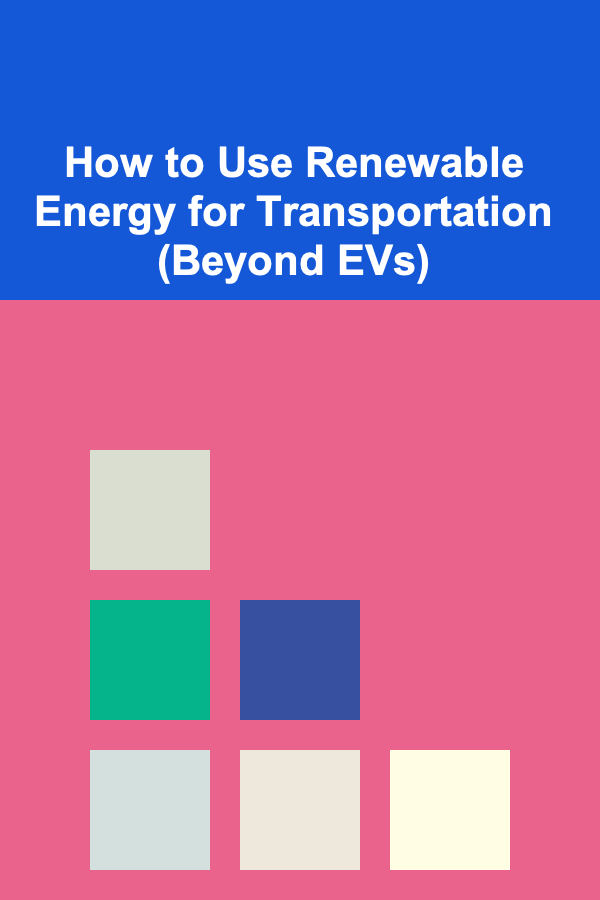
How to Use Renewable Energy for Transportation (Beyond EVs)
ebook include PDF & Audio bundle (Micro Guide)
$12.99$10.99
Limited Time Offer! Order within the next:

In recent years, renewable energy has become a cornerstone of global efforts to combat climate change, reduce greenhouse gas emissions, and transition toward a more sustainable future. While electric vehicles (EVs) have garnered significant attention as a solution for decarbonizing transportation, they are not the only option. Beyond EVs, there is a range of innovative renewable energy solutions that can be applied to various forms of transportation. This article will explore the potential of renewable energy sources such as hydrogen, biofuels, solar power, and wind energy in reshaping the transportation landscape.
The Challenges of Transportation and Climate Change
Transportation is one of the largest contributors to global greenhouse gas emissions. In 2021, it accounted for around 14% of global emissions, with road transport making up the majority of that total. Cars, trucks, buses, trains, ships, and airplanes all rely heavily on fossil fuels, primarily gasoline and diesel, which release harmful pollutants into the atmosphere.
The urgency of transitioning away from fossil fuel-based transportation is clear. Rising CO2 levels in the atmosphere contribute to the warming of the planet, exacerbating natural disasters, melting polar ice caps, and driving sea-level rise. The transportation sector must undergo a fundamental transformation to achieve global climate goals, and renewable energy offers one of the most promising solutions.
The Role of Renewable Energy in Transportation
Renewable energy can play a crucial role in transforming transportation systems by providing clean, sustainable alternatives to fossil fuels. While electric vehicles (EVs) have received much attention due to their zero tailpipe emissions, renewable energy sources can be applied in other ways to power different forms of transport, including buses, trains, ships, and even airplanes.
2.1. Hydrogen: A Clean Fuel for Heavy-Duty Transport
Hydrogen has long been recognized as a potential fuel for transportation, especially for applications where battery electric vehicles (BEVs) may not be the most practical option. Unlike BEVs, hydrogen fuel cell vehicles (FCVs) produce electricity through a chemical reaction between hydrogen and oxygen, emitting only water vapor as a byproduct. This makes hydrogen a promising zero-emission alternative to diesel and gasoline for heavy-duty vehicles, such as trucks, buses, and trains.
2.1.1. Hydrogen Production
The key to using hydrogen as a renewable energy source is the method of production. While hydrogen is abundant, it does not naturally exist in its pure form on Earth. It must be extracted from compounds like water, natural gas, or biomass. Currently, the majority of hydrogen production relies on natural gas, a process known as "gray hydrogen," which releases significant amounts of CO2. However, there are cleaner alternatives.
- Green hydrogen is produced through the electrolysis of water, using electricity generated from renewable sources such as wind, solar, or hydroelectric power. This process splits water molecules into hydrogen and oxygen, emitting no carbon emissions.
- Blue hydrogen is produced similarly to green hydrogen but incorporates carbon capture and storage (CCS) technology to trap and store CO2 emissions from the process.
Green hydrogen holds the most promise for a sustainable future, as it is entirely carbon-free and can be used for various applications, including transportation, power generation, and industrial processes.
2.1.2. Hydrogen Fuel Cells for Transportation
Hydrogen fuel cell vehicles offer significant advantages for certain types of transport. Unlike EVs, hydrogen-powered vehicles can be refueled in just a few minutes, making them highly practical for long-distance travel and heavy-duty applications. Hydrogen-powered trains, buses, and trucks are already being tested and deployed in several countries.
For instance, Germany has introduced hydrogen-powered trains on certain rail lines, while Japan has developed hydrogen buses for urban transportation. Several global automakers, such as Toyota and Hyundai, have also developed hydrogen-powered passenger cars, and the technology is rapidly advancing.
2.1.3. The Future of Hydrogen in Transportation
The future of hydrogen-powered transport depends on several factors, including cost reductions in hydrogen production, advancements in fuel cell technology, and the development of a widespread refueling infrastructure. The growing interest in green hydrogen, fueled by government policies and investments in clean energy, could make hydrogen a key player in decarbonizing transportation in the coming decades.
2.2. Biofuels: Renewable Fuels for Aviation and Shipping
While electric vehicles and hydrogen fuel cells are gaining attention, biofuels are also playing an essential role in reducing the carbon footprint of transportation, particularly in sectors where electrification or hydrogen may not be feasible. Biofuels, derived from organic materials such as plants, algae, or waste, can be used as a direct substitute for gasoline, diesel, or jet fuel.
2.2.1. Types of Biofuels
There are several types of biofuels, each with unique characteristics and applications:
- Biodiesel: Produced from vegetable oils, animal fats, or algae, biodiesel can be used to power diesel engines. It is already in widespread use in buses, trucks, and agricultural machinery.
- Ethanol: Typically made from corn, sugarcane, or other plant materials, ethanol is commonly blended with gasoline to reduce emissions in internal combustion engines. Many countries, including the United States and Brazil, have implemented ethanol-based fuel programs.
- Sustainable aviation fuel (SAF): Aviation is one of the most challenging sectors to decarbonize. However, biofuels derived from waste products or specially cultivated plants can be processed into sustainable aviation fuel (SAF), which can be used in existing aircraft engines without significant modifications.
2.2.2. Advantages and Challenges of Biofuels
Biofuels offer a promising solution to reducing emissions in transportation. They can be produced from a variety of renewable feedstocks, including agricultural waste, algae, and even municipal solid waste. They are also compatible with existing infrastructure, meaning they can be used in traditional vehicles and engines with minimal modification.
However, biofuels come with several challenges. The large-scale production of biofuels can compete with food production, leading to concerns about land use, food security, and the environmental impacts of monoculture farming. Additionally, the carbon neutrality of biofuels depends on the source of the feedstock and the production methods. Some biofuels may still produce significant emissions during cultivation, processing, and transportation.
Despite these challenges, biofuels can play a vital role in decarbonizing transportation, particularly in sectors such as aviation and shipping, where electrification and hydrogen are not yet practical.
2.3. Solar Power: Harnessing the Sun for Transport
Solar energy is another renewable resource with great potential for transportation. While solar panels are commonly used for electricity generation, there are innovative ways to integrate solar energy into transportation systems, reducing reliance on grid power and fossil fuels.
2.3.1. Solar-Powered Vehicles
Solar-powered vehicles have been under development for several years, with prototypes ranging from small cars to larger buses. Solar panels are integrated into the vehicle's surface, capturing sunlight and converting it into electricity to power the vehicle's motor. In ideal conditions, a solar-powered car could operate without the need for any additional charging.
However, solar power for transportation faces significant limitations. The amount of energy that can be captured from solar panels on a vehicle's surface is relatively small compared to the energy requirements of a car, especially over long distances. Solar vehicles are more practical for use in sunny regions and for short trips, but they are unlikely to replace conventional electric vehicles on a large scale.
2.3.2. Solar-Powered Charging Stations
A more practical application of solar energy in transportation is through the development of solar-powered charging stations. By installing solar panels at charging stations, vehicles can recharge using clean energy, reducing the carbon footprint of electric vehicles. This is particularly useful in remote areas or regions with high levels of solar radiation, where grid electricity may not be as reliable.
2.3.3. The Future of Solar in Transportation
While solar-powered vehicles may not be a widespread solution for mass transportation, solar energy has the potential to play a significant role in charging infrastructure. With advancements in solar panel efficiency and battery storage, solar energy can become an essential part of the renewable energy mix for transportation.
2.4. Wind Energy: Powering Transport via the Grid
Wind energy is one of the fastest-growing renewable energy sources in the world. It can be harnessed to produce electricity, which can then be used to power electric vehicles and other forms of transportation. Wind farms, both onshore and offshore, generate vast amounts of energy, which can be fed into the grid to supply clean electricity to EV charging stations, electric railways, and even electric ships.
2.4.1. Offshore Wind and Maritime Transport
Wind energy is also being explored as a direct power source for maritime transport. Large commercial vessels, such as cargo ships and ferries, are significant sources of emissions. By harnessing the power of wind through technologies like kite sails and rotor sails, ships can reduce their reliance on traditional fuel sources, making maritime transport more sustainable.
2.4.2. Wind-Powered Trains and Electric Railways
Wind energy can also be used to power electric rail systems. In regions where wind farms are abundant, the energy generated by wind turbines can be fed directly into the electric grid, powering trains and reducing the carbon footprint of rail travel. Some European countries, including the Netherlands, have already begun integrating wind energy into their electric railway systems.
Integrating Renewable Energy into Transportation Infrastructure
To fully realize the potential of renewable energy in transportation, it is crucial to develop the necessary infrastructure to support these technologies. This includes the expansion of charging networks, refueling stations, and renewable power generation facilities. Governments, private companies, and consumers must work together to create an ecosystem that makes sustainable transportation choices more accessible and practical.
Conclusion
While electric vehicles have garnered much attention in the quest to decarbonize transportation, renewable energy offers a much broader range of solutions beyond EVs. Hydrogen, biofuels, solar power, and wind energy each have unique advantages in powering different forms of transport, from buses and trains to ships and airplanes. The future of sustainable transportation lies in the integration of these renewable energy sources into a diverse, interconnected network that can meet the transportation needs of the modern world while minimizing environmental impacts. The transition to renewable energy for transportation is not only possible---it is essential for a sustainable future.

How to Organize Your Grocery Shopping Checklist for Maximum Efficiency
Read More
How to Repurpose Old Decorations for a Fresh Holiday Look
Read More
How to Use Acoustic Panels to Soundproof Your Living Room
Read More
Smart Ways to Break the Habit: Cutting Down on Impulse Buying
Read More
10 Tips for To-Do Lists for Students: Balancing Academics & Life
Read More
10 Tips for a Birthday Party Checklist for Children with Allergies
Read MoreOther Products

How to Organize Your Grocery Shopping Checklist for Maximum Efficiency
Read More
How to Repurpose Old Decorations for a Fresh Holiday Look
Read More
How to Use Acoustic Panels to Soundproof Your Living Room
Read More
Smart Ways to Break the Habit: Cutting Down on Impulse Buying
Read More
10 Tips for To-Do Lists for Students: Balancing Academics & Life
Read More